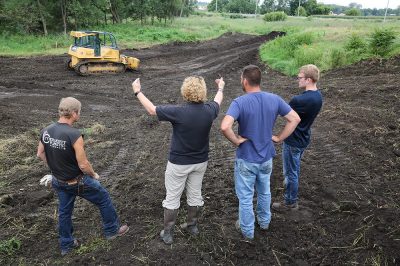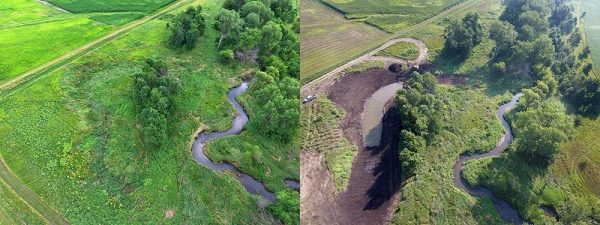Oxbow Restorations Benefit Habitat, Ecosystem

Before Europeans arrived in Iowa, the state’s streams were shallow and often spilled out of their banks after a heavy rain. Most of the time, though, they meandered lazily across the rolling landscape, taking their time to reach the eventual destination.
When Iowans straightened rivers and creeks in the 20th century, they likely didn’t understand the chain reaction they had set in motion. They simply wanted to make their land easier to farm. But according to IIHR Research Engineer Chris Jones, the straightened dredge ditches of today are disconnected from the floodplain and have lost much of their ability to process nutrients. The water moves faster, eroding downward and increasing the flood risk downstream.
A Haven for Wildlife
Jones says that although it is impossible to re-meander all of Iowa’s streams, it is feasible to restore some of the oxbows that have been lost over the last century or so. An oxbow is usually in the shape of a horseshoe or a C because it’s a historic river bend, cut off from the main channel most of the time. Restored oxbows can re-establish part of the ecological function of the system while also providing habitat for the fish, birds, reptiles, and amphibians that like these quiet backwaters. Oxbows can also process nutrients, and they’re surprisingly affordable.
“Habitat projects tend to be really expensive because they involve land retirement,” Jones says. But oxbow restorations are usually on land in the floodplain that is unusable anyway. “It’s very cheap habitat—$10,000 to $15,000 to restore one of these,” he explains. Crews with earth-moving equipment remove the accumulation of sediment down to the native sands and gravels that were once the river bottom. The oxbow then fills in with water, and that’s pretty much it, Jones says.
He’s part of a project to restore an oxbow in Morgan Creek Park in Linn County—the first restored oxbow in eastern Iowa. A nearby trail makes the Morgan Creek site accessible to hikers, and Linn County Conservation staff have reseeded the surroundings with beneficial plants. “It’ll provide opportunities for people to look at birds,” Jones says. Sometimes sport fish even colonize an oxbow, making it a haven for fishermen. Oxbows can also provide some flood storage capacity.
Jones say he and his colleague Keith Schilling, along with graduate student Bryce Haines, want to quantify the water-quality benefits of restored oxbows. They’ve installed monitoring wells near Morgan Creek to help assess water quality.

Nitrate Processing
IIHR researchers also conducted an oxbow restoration project last year in the Boone River Watershed, with collaboration from The Nature Conservancy and the Iowa Soybean Association, and funding from the Iowa Nutrient Research Center. Schilling led a team including Harvest Ellis and Nate Young that set out to map potential oxbow restoration sites in the Boone River basin using GIS and LiDAR (laser radar) data. According to Schilling, they found hundreds of sites that could be restored.
In addition, Schilling’s team set up intensive water-quality monitoring on a restored oxbow on White Fox Creek, also in the Boone watershed. Discharge from two tiles partially feeds the oxbow. Schilling says they found that the White Fox oxbow removed 45 percent of nitrate from the water—a level comparable to nitrate processing by wetlands or bioreactors. Because restored oxbows are often on marginal agricultural land, they can be an attractive option for producers looking for a best management practice for tile drainage. “You get treatment and ecosystem value,” Schilling says. In the future, he hopes to develop a conservation practice standard for oxbows.
Jones agrees that oxbow restoration can check off a lot of boxes. “Oxbows can provide a triple benefit of habitat, flood storage, and stream water-quality enhancement,” he says. “And all for not much money.”